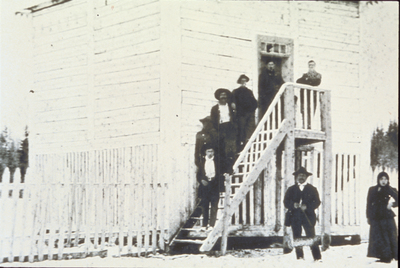
4. Fish Cache
The fur traders got the idea for this building from the local First Nations group, The Dakelh (or Carrier) people, who built elevated fish caches to store dried salmon for the winter. The building is raised by four corner elevated posts to deter predators.
Picture: Men stand on fish cache stairs.
Transcript:
Carrier fishing technology was highly specialized and sophisticated. Fish were appropriated with seven different types of weirs and traps depending on water conditions. There are many other descriptions of this fishing technology, many expressing of wonder and praise for these machines. The men at Fort St. James in 1820 to 1821 had a daily allowance of four fish per man, while doing work in the winter a man and a dog together got eight per day.
“In the early days, getting enough to eat was a real problem. There was no big game, the soil was poor, the growing season short, and we were too far from civilization to import much food. Not only were we dependent on the Carriers to trap the furs, but to catch and preserve the thirty or forty thousand fish we ate each year.” (Quote from George Holder)
“You know I am generally a slender person what would you say if you saw my emaciated body now. I am every morning when dressing in danger of slipping through my breeks and falling into my boots, many a night I go to bed hungry and craving for something better than this horrid dried salmon we are obliged to live upon. – These hardships are enough to drive me out of the country.” (Quote from Thomas Dears)
-
Welcome
-
1. Ramp to the Lake
-
2. Flagpole
-
3. The Fur Warehouse
-
4. Fish Cache
-
5. The Guest House
-
6. The Interpreter's House
-
7. The Garden
-
8. Trade Store
-
9. A) The officer's Dwelling House
-
9. B) Looking into the Parlour